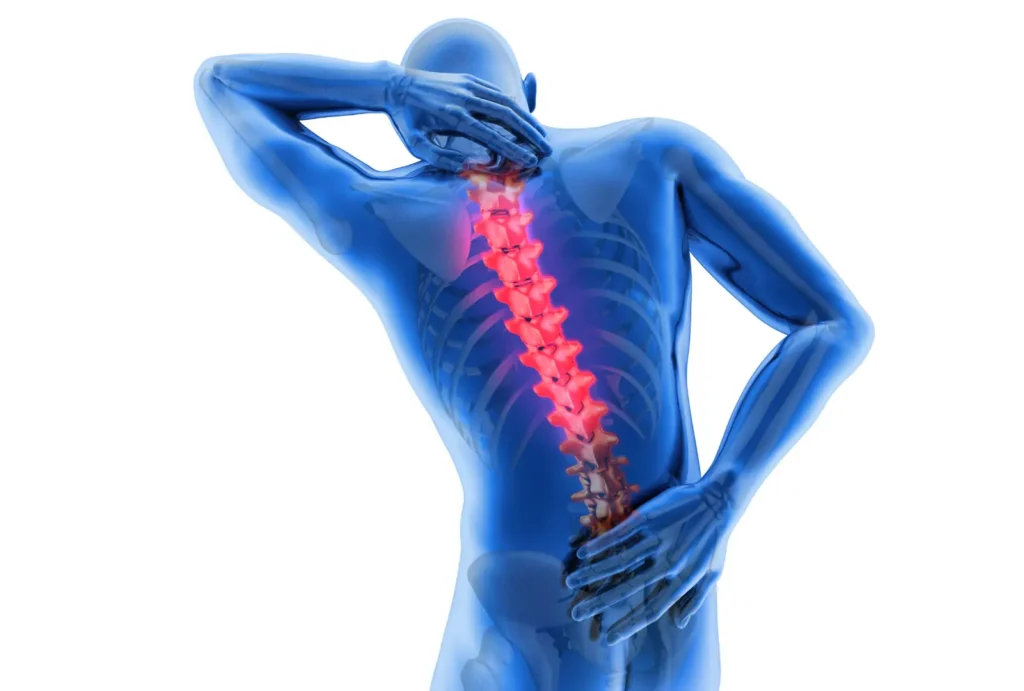Common Conditions
Thoracic spine pain
Thoracic spine pain is a description rather than an actual diagnosis and refers to spine pain experienced between the cervical and lumbar regions. This region consists of twelve vertebrae that connect to the ribcage, providing stability and protecting vital organs like the heart and lungs. While thoracic spine pain is less common than pain in the neck or lower back, it can still result from various causes, including injury, poor posture, or underlying medical conditions.

What causes thoracic spine pain?
Thoracic spine pain can arise from several factors, such as:
- Degenerative changes: Conditions including arthritis or age-related wear and tear can affect the joints and discs in the thoracic spine.
- Scheuermann’s Disease: A common condition found in 5–10% of the population which develops during growing years can occasionally cause thoracic spine pain and stiffness.
- Injury or trauma: Falls, car accidents, or sports injuries can damage the vertebrae, discs, or surrounding muscles in the thoracic spine.
- Herniated discs: Although less common in the thoracic spine, a herniated disc can press on nearby nerves, causing pain.
- Scoliosis or kyphosis: Severely abnormal curvatures of the spine can lead to uneven pressure and pain in the thoracic region.
- Underlying conditions: Osteoporosis, infections, or inflammatory conditions including ankylosing spondylitis can also contribute to thoracic spine pain.
Common symptoms of thoracic spine pain
Thoracic spine pain can present in a variety of ways, depending on the cause:
- Localized pain: A dull, sharp, or aching sensation in the mid-back.
- Radiating pain: Pain that spreads to the chest, ribs, or shoulder blades.
- Stiffness: Difficulty moving the upper back, especially after periods of inactivity.
- Muscle tightness: Tension or spasms in the muscles surrounding the thoracic spine.
- Pain with movement: Certain activities, such as twisting, bending, taking a deep breath or lifting, may worsen the pain.
- Nerve-related symptoms: In rare cases, nerve compression may cause tingling, numbness, or weakness in the chest or upper abdomen.
Diagnosing the cause of thoracic spine pain
Diagnosing the cause of thoracic spine pain starts with a thorough history and physical examination. Dr Young will ask about the location, nature, and duration of your pain, as well as any related symptoms such as stiffness, radiating pain, or difficulty with movement. They may assess posture, spinal alignment, muscle tension, and neurological function.
Imaging tests may be recommended if pain is persistent, severe, or unexplained. These can include:
- X-rays to evaluate bone alignment, fractures, or signs of arthritis.
- MRI scans to assess soft tissues, discs, and nerve involvement.
- CT scans, EOS scans or bone scans for more detailed bone and joint imaging.
In rare cases, blood tests may be ordered to rule out infection, inflammation, or tumours.
The goal is to identify the underlying cause and guide appropriate treatment.
Management of thoracic spine pain
Treatment for thoracic spine pain depends on the underlying cause and severity of the condition. Common options include:
- Physical therapy: Exercises to strengthen the back muscles, improve posture, and enhance flexibility can help alleviate pain and prevent recurrence.
- Medications: Simple or prescription pain relievers, anti-inflammatory drugs, or muscle relaxants can reduce discomfort.
- Lifestyle adjustments: Adopting better posture, using ergonomic furniture, and avoiding activities that strain the spine can support recovery.
- Manual therapy: Chiropractic adjustments or massage therapy may help relieve tension and improve mobility.
- Injections: Corticosteroid injections may provide temporary relief for severe pain or inflammation.
- Radiofrequency neurotomy of the thoracic facet joints can help in selected cases with proven painful arthritis of the facet joints.
- Surgical options: In very rare cases, surgery may be required to address structural issues, such as a herniated disc or spinal instability.

